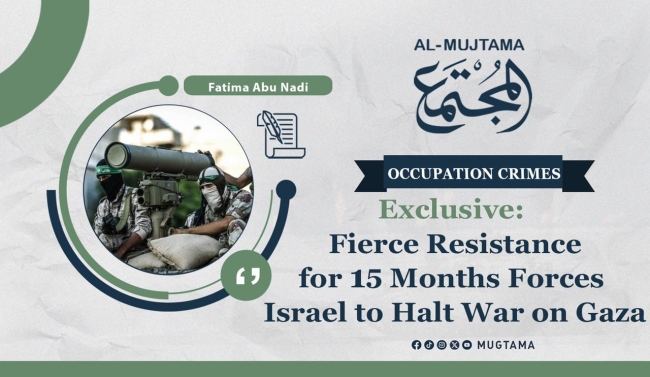Exclusive: Fierce Resistance for 15 Months Forces Israel to Halt War on Gaza Featured
After 15 months of intense negotiations and a lengthy period of Arab diplomacy, “Israel” and Hamas revealed a ceasefire agreement via the assistance of Egypt, Qatar, and the U.S. government. Israelis and Palestinians are waiting for the ceasefire agreement to be implemented on Sunday, January 19, 2025, which will be implemented in stages with the first stage extending six weeks and that involve the following items:
The exchange of 1,000 Palestinian detainees in Israel for the release of 33 hostages detained in the Gaza Strip.
Thirty Palestinian detainees are freed for each Israeli female soldier. without interruption return of the displaced to northern Gaza.
The names of 95 Palestinian detainees who will be released beginning Sunday, January 19, 2025 as part of an initial exchange process in line with the ceasefire agreement with Hamas were revealed by Israeli officials on Friday.
After 15 months of intense negotiations and a lengthy period of Arab diplomacy, “Israel” and Hamas revealed a ceasefire agreement via the assistance of Egypt, Qatar, and the U.S. government. Israelis and Palestinians are waiting for the ceasefire agreement to be implemented on Sunday, January 19, 2025, which will be implemented in stages with the first stage extending six weeks and that involves the following items:
- The exchange of 1,000 Palestinian detainees in Israel for the release of 33 hostages detained in the Gaza Strip
- Thirty Palestinian prisoners will be released for every Israeli female soldier.
- The return of displaced persons to northern Gaza will continue without interruption.
The names of 95 Palestinian detainees who will be released beginning Sunday, January 19, 2025, as part of an initial exchange process in line with the ceasefire agreement with Hamas were revealed by Israeli officials on Friday.
Final status arrangements mechanism
According to U.S. President Joe Biden, the first stage of the agreement calls for a "comprehensive ceasefire," the release of 33 hostages, including women, children, and the elderly, an Israeli withdrawal from populated areas of the Gaza Strip, and an increase in the amount of humanitarian aid entering the area "600” aid trucks per day once the truce takes effect.
Despite the announcement by Qatar and the US of reaching a ceasefire agreement on Wednesday, the Israeli army continued its airstrikes on the Gaza Strip. The airstrikes resulted in the deaths of more than 110 people, including 60 women and children, according to the Ministry of Health and Civil Defense in the region.
Arrangements for the stage of negotiation will be discussed during the first stage. There were pivotal periods during the complex negotiations, which were mediated by the United States, Qatar, and Egypt, when the parties exchanged suggestions.
While Israel postponed its government meeting to approve the truce, Hamas was accused of making new demands. Israeli airstrikes have killed over 86 people in Gaza since the truce was issued, leaving the locals feeling sad and angry. "Put a definitive end to the war," is the target of the second stage, according to Qatari Prime Minister Mohammed bin Abdulrahman Al Thani
The second and third stages
“The Israeli negotiating delegation is still in Doha to finalize the technical details, and the terms and all related details will be agreed upon during the implementation of the first stage.” The prime minister of Qatar stated that the second and third stages are conditional upon the progress of the first stage.
It appears that Netanyahu's administration is not serious about the Israeli government's withdrawal from the Philadelphi Passage along the Egyptian border, despite Israeli media reporting on intense disagreements that have deepened the rift within the small Israeli cabinet as a result of the agreement's signing.
Although Israeli Prime Minister Benjamin Netanyahu delayed the government's planned approval date of the ceasefire accord, this shows how deeply divided the Cabinet is. The obvious disputes and threats made by Ben Gvir, the security file official, who threatened to leave the government, were also brought to light by Israeli media.
The prime minister of Qatar affirmed that the second and third stages of the agreement will be developed while the first stage is being implemented, regardless of how inflexible the Israeli government is. "Israel will negotiate in the next six weeks the necessary arrangements to move forward to the second stage, which will represent the decisive end of the war," the departing American president added: " I repeat the decisive end of the war"
"There will be an exchange for the release of the remaining hostages, including male soldiers, and all remaining Israeli forces will withdraw from Gaza when the second stage begins," Biden said. The temporary ceasefire will then turn into a permanent one.
The beginning of the ceasefire at the Rafah crossing
Since any executive action will be within the borders of the Egyptian state, the truce will begin today, Sunday, January 19, 2025, when Egypt will receive the first three detainees. Since the exchange of hostages and inmates is seen as a security event for Egypt, Egypt declared that it has placed all security organizations the Ministry of Health, and the Egyptian government under a high level of alert during the process.
Egypt was selected to participate in the prisoner exchange process because it wants to see the agreement through to its completion in order to avoid any conflict between Israel and Hamas and keeping the conditions of the truce in place for the next six weeks because a prisoner exchange is unsuitable in Gaza, which has been destroyed by the murder.
Priority will be given to the injured during the truce period, as well as to the arrival of medical aid and medical groups. In order to resume medical operations within the Gaza Strip, Egypt will also permit fuel to enter through the Rafah border crossing.
After being security-checked at the Rafah gate, humanitarian aid will first pass via the Karam Abo Salem border before being transported to Israel, which will then deliver it to the UN for delivery to the Gaza Strip. Since the Rafah crossing is regarded as a Palestinian property, Egypt strongly rejects any Israeli oversight there and will return to the 2005 agreement.
The leadership battle between the Palestinian Authority and Hamas on the day after the war
The complexity of the split following each confrontation with the Israeli occupation is seen in the struggle between the Palestinian Authority and Hamas. The leaders of the Palestinian National Authority insist that Hamas leave and allow the Palestinian people to truly choose their own future, while the Authority rejects any future decisions that do not involve them. Despite the 2007 divide the Authority fulfilled its duties to provide funding for infrastructure, education, and health.
According to Hamas leaders, a state of consensus is necessary, and all Palestinian divisions, including Hamas, must agree on a complete strategic management plan in order to rebuild Gaza. Hamas recognizes that the agreement's drafters do not want Hamas to be present in Gaza.
Israel has made it clear that it will not permit political control of the Gaza Strip by Hamas or the Palestinian Authority, and that the presence of Palestinian officials under American leadership will be sufficient. Gaza's future still depends on the Palestinian leadership' resolve to put behind their differences and create an equal future vision for the Gaza Strip. Israel's decision to leave the Gaza Strip without recognizing its new ruler is consistent with its earlier decision to keep Hamas' control over the area and its complete rejection of the Palestinian Authority.
The "Gaza State" scenario, which entails establishing an independent committee under regional and international supervision to restore the Gaza Strip and all of its institutions under its authority, may become a possibility given the chaotic events taking place in Gaza.


